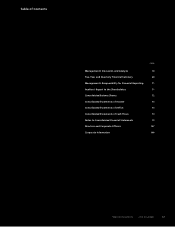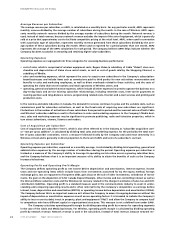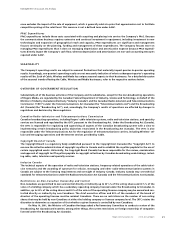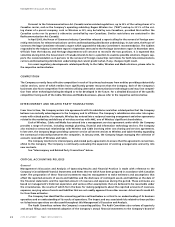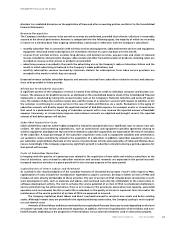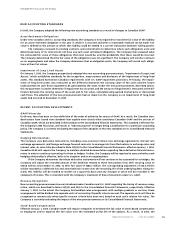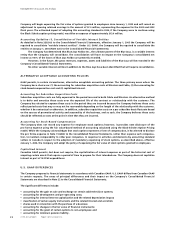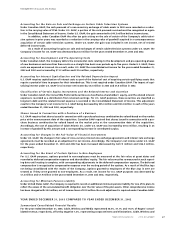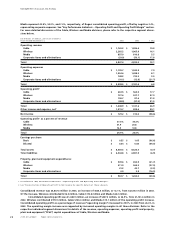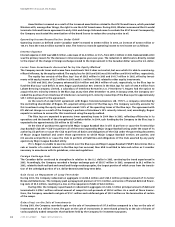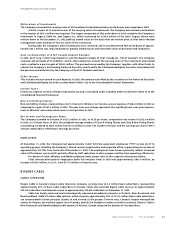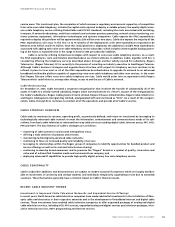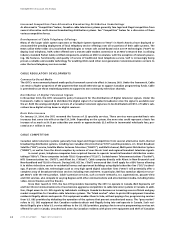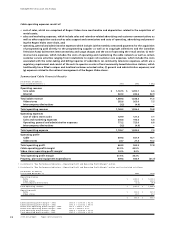Rogers 2003 Annual Report Download - page 28
Download and view the complete annual report
Please find page 28 of the 2003 Rogers annual report below. You can navigate through the pages in the report by either clicking on the pages listed below, or by using the keyword search tool below to find specific information within the annual report.
2003 Annual Report Rogers Communications Inc.
26
Company will begin expensing the fair value of options granted to employees since January 1, 2002 and will record an
adjustment to opening retained earnings in the amount of $7.0 million, representing the expense for the 2002 and 2003
fiscal years. The estimated impact of adopting this accounting standard in 2004, if the Company were to continue using
the Black-Scholes option pricing model, would be an expense of approximately $13.0 million.
Accounting Guideline 15, Consolidation of Variable Interest Entities
As detailed in Note 2((t)(iv)) to the Consolidated Financial Statements, effective January 1, 2005 the Company will be
required to consolidate “variable interest entities”. Under U.S. GAAP, the Company will be required to consolidate the
entities on January 1, 2004 (Note 22(r) to the Consolidated Financial Statements).
The Company has determined that Blue Jays Holdco Inc., the ultimate parent of the Blue Jays, is a variable interest
entity that the Company will consolidate. The consolidation will have no impact on the Company’s consolidated net
income as 100% of the losses of Blue Jays Holdco are presently recorded.
However, in the future, the gross revenues, expenses, assets and liabilities of the Blue Jays will be recorded in the
Company’s Consolidated Financial Statements.
No other variable interest entities in addition to the Blue Jays have been identified that will require consolidation.
ALTERNATIVE ACCEPTABLE ACCOUNTING POLICIES
GAAP permits, in certain circumstances, alternative acceptable accounting policies. The three primary areas where the
Company has a choice are: (1) the accounting for subscriber acquisition costs at Wireless and Cable, (2) the accounting for
stock-based compensation cost and (3) capitalized interest.
Accounting for Subscriber Acquisition Costs
Subscriber acquisition costs are fully expensed in the period incurred in both Cable and Wireless. An alternative method
is to defer and amortize these costs over the expected life of the contract or relationship with the customer. The
Company has elected to expense these costs in the period they are incurred because the Company believes these costs
reflect period costs that may or may not be recoverable depending on the length of the relationship with the customer,
whether it be contractual or otherwise. In addition, subscriber acquisition costs on a per subscriber basis fluctuate based
on the success of promotional activity and seasonality of the business, and as such, the Company believes these costs
should be reflected as costs at the point in time that they are incurred.
Accounting for Stock-Based Compensation
The Company does not record any expense for employee stock options; however, it provides note disclosure of the
pro forma expense using the fair value-based method of accounting calculated using the Black-Scholes Option Pricing
model. While the Company acknowledges that stock options represent a form of compensation, it has elected to disclose
the pro forma expense in Note 11((d)(i)) to the Consolidated Financial Statements, rather than expense such compensa-
tion, to maintain comparability to other peer companies. In response to activities and decisions by accounting standard
setters in Canada in respect to the adoption of mandatory expensing of stock options, as described above, effective
January 1, 2004, the Company will adopt the policy of expensing the fair value of stock options granted to employees.
Capitalized Interest
Canadian GAAP permits, but does not require, the capitalization of interest expense as part of the historical cost of
acquiring certain assets that require a period of time to prepare for their intended use. The Company does not capitalize
interest as part of its PP&E expenditures.
U.S. GAAP DIFFERENCES
The Company prepares its financial statements in accordance with Canadian GAAP. U.S. GAAP differs from Canadian GAAP
in certain respects. The areas of principal differences and their impact on the Company’s Consolidated Financial
Statements are described in Note 22 to the Consolidated Financial Statements.
The significant differences include:
• accounting for the gain on sale and exchange on certain cable television systems;
• accounting for development and pre-operating costs;
• accounting for internal interest capitalization and the related depreciation impact;
• classification of certain equity instruments and the related interest and accretion;
• shares used in connection with the purchase of a business;
• accounting for changes in the fair value of financial instruments;
• accounting for the grant of certain options to non-employees; and
• accounting for minimum pension liability.
Management’s Discussion and Analysis



